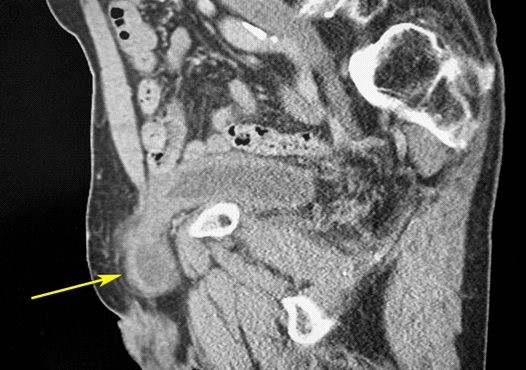
Journal of Clinical Images and Medical Case Reports
ISSN 2766-7820
Clinical Image - Open Access, Volume 3
Indirect inguinal hernia of the urinary bladder
Wade Hopper1*; Matthew Forte2
1 Department of Surgery, Edward via College of Osteopathic Medicine, Spartanburg, SC, USA.
2 Regional Medical Center, Orangeburg, SC, USA.
*Corresponding Author: Wade Hopper
Department of Surgery, Edward via College of
Osteopathic Medicine - Carolinas, Spartanburg, SC,
USA
Email: whopper@vcom.edu
Received : Feb 04, 2022
Accepted : Mar 01, 2022
Published : Mar 08, 2022
Archived : www.jcimcr.org
Copyright : © Hopper W (2022).
Citation: Hopper W, Forte M. Indirect inguinal hernia of the urinary bladder. J Clin Images Med Case Rep. 2022; 3(3): 1719.
Description
An 83-year-old man was diagnosed with stage IIIA follicular small cleaved cell lymphoma in June 2021. Treatment with rituximab x4 weekly was initiated. Routine CT scanning was obtained in August 2021 to determine response to treatment. A right-sided indirect inguinal hernia was encountered at this time which had not been present upon prior examinations. The hernia sac was found to contain a significant anterior extension of the urinary bladder. An enlarged prostate was also observed measuring 6.2 cm transversely. The patient experienced no lower urinary tract symptoms at this time. Surgical repair of the hernia was deferred because the patient self-reported minimal discomfort and minimal functional restriction due to the hernia.
Computed tomography scans are shown in the axial (Figure 1) and sagittal (Figure 2) planes demonstrating the presence of the urinary bladder extruding through the hernia sac and outside the pelvis.
Inguinal herniation of the urinary bladder is a rare phenomenon occurring in less than 5% of inguinal hernias [1-4]. The presence of this condition may complicate the repair of inguinal hernias, as the urinary bladder may be accidentally cut if its presence in the hernia sac is unexpected [2]. Medical practitioners encountering inguinal hernias should understand the potential for the bladder to extrude into the hernial sac, and that this can occur in the absence of lower urinary tract symptoms. This condition can be safely managed with either open or laparoscopic surgical repair [2,3].
Extrusion of the urinary bladder occurs in around 3% of inguinal hernias. We report computed tomography scans demonstrating this rare phenomenon encountered in an 83-year-old male patient undergoing chemotherapy for Non-Hodgkin’s lymphoma who presented without lower urinary tract symptoms.
References
- Bisharat M, O’Donnell ME, Thompson T, et al. Complications of inguinoscrotal bladder hernias: A case series. Hernia. 2009; 13: 81-84.
- Taskovska M, Janež J. Inguinal hernia containing urinary bladder—A case report. Int J Surg Case Rep. 2017; 40: 36-38.
- Khan A, Beckley I, Dobbins B, Rogawski KM. Laparoscopic repair of massive inguinal hernia containing the urinary bladder. Urol Ann. 2014; 6: 159-162.
- Papatheofani V, Beaumont K, Nuessler NC. Inguinal hernia with complete urinary bladder herniation: A case report and review of the literature. J Surg Case Reports. 2020; 1: 1-2.


